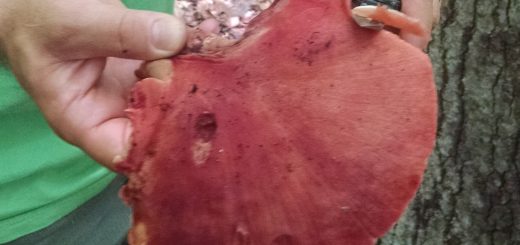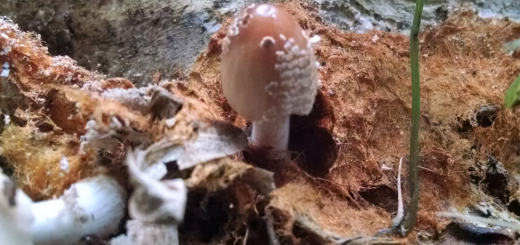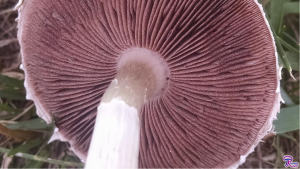#126: Xylobolus frustulatus, the Ceramic Fungus
Xylobolus frustulatus is one of my favorite fungi. It’s not particularly interesting, but there is just something surreal about the way it covers the surfaces of logs. From a distance, the fungus looks like a thin layer of weathered paper or parchment covering the surface of a log. Upon closer inspection, however, the fruiting bodies look more like a mosaic composed of tiny, white, ceramic tiles. Thanks to its unique appearance, frustulatus is often called either “the Ceramic Fungus” or “the Ceramic Parchment.”
X. frustulatus is easy to identify. The individual fruiting bodies are fairly small: up to 1cm across and only a few millimeters thick. Each “tile” (or “frustule,” to mycologists) is shaped like an irregular polygon, has a smooth, white top, has sides that are black or dark brown, and has a wood-like consistency. The upper surface is irregularly lumpy but smooth and bears an uncanny resemblance to ceramic in both texture and color. It is from this surface that the spores are released. As the mushroom ages, this surface becomes pale pinkish to pale orangish with mature spores and then slowly turns brown. Wikipedia states that the fruiting bodies are perennial and that you can see faint zone lines around the tiles’ edges. A perennial mushroom forms a new layer of spore-producing tissue on top of the old fruiting body every year. As a result, the zone lines around the edges represent old layers of growth, much like the rings of a tree. This is not confirmed by the other sources listed below, but it does agree with my own observations.
Unlike most mushrooms, the Ceramic Fungus does not change the shape of its fruiting bodies based on its substrate’s orientation. A tile growing on top of a log will have its white, fertile surface pointed up (oriented parallel to the log and ground) while one growing on the side of a log will have that surface pointing sideways (oriented parallel to the log but perpendicular to the ground). However, the tiles oriented sideways are more efficient at dropping spores into air currents. As a result, X. frustulatus avoids producing fruiting bodies on the tops of logs. In my experience, tiles growing on the side of a log will have a slightly thicker top edge, making them somewhat wedge-shaped. This subtle change in shape improves the spores’ chances of falling into an air current rather than onto another part of the fruiting body.
Although each tile is fairly small, the fungus can produce hundreds of tiles and completely cover large areas on a log. The ceramic tile effect is most pronounced when the fungus is fruiting on the cut face of a felled tree. Luckily, X. frustulatus appears to like fruiting on such flat surfaces and it is common to find the fungus coating the entire cut face of an infected log.
The Ceramic Fungus can be found in North America, Europe, and Asia. It is a white rot fungus (it decomposes lignin, leaving behind white cellulose fibers) that prefers to break down dry, well-rotted oak wood. Occasionally, the fungus can be found on other hardwoods. X. frustulatus is easiest to spot when it is growing on large logs, but the fungus can be found on smaller pieces of wood as well. The tough fruiting bodies are quite resilient and can be found any time of the year.
If you have a microscope, Michael Kuo – the author of MushroomExpert.com – recommends using it examine X. frustulatus. Under the microscope, the Ceramic Fungus features unusual-looking cells called “acanthocystidia” on its fertile surface. These are large, sterile cells that have many, tiny protrusions on their tips, making them look like tiny bottle brushes.
Xylobolus frustulatus belongs to the phylum Basidiomycota, class Agaricomycetes, order Russulales, and family Stereaceae. Its closest relatives are other crust fungi (such as Stereum complicatum), which all have smooth spore-bearing surfaces.
See Further:
http://www.mushroomexpert.com/xylobolus_frustulatus.html
https://en.wikipedia.org/wiki/Xylobolus_frustulatus
http://www.mushroomfarm.com/mushroom-species/crust-fungi/xylobolus-frustulatus.html









![#011: Characteristics of Kingdom Fungi [Archived]](https://www.fungusfactfriday.com/wp-content/themes/hueman/assets/front/img/thumb-small-empty.png)


1 Response
[…] instead of fruiting from a single point. One of my favorite crust fungi with this morphology is Xylobolus frustulatus. It produces flattened, white bumps that press up against each other, giving the surface a […]